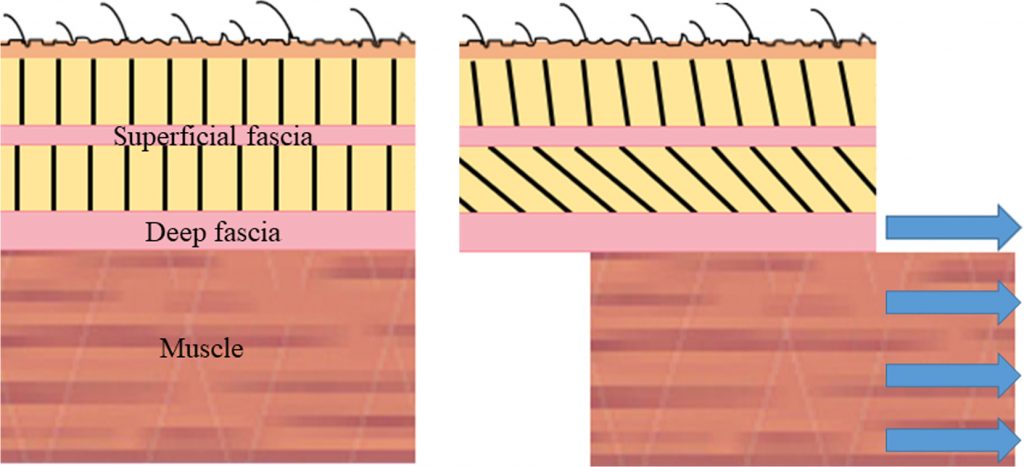Direct mechanical relationship between the superficial fascia and the skeletal muscles
Proposed mechanical interaction between the deep fascia and the skeletal muscle. In resting conditions (left), a displacement of the muscle (right) will stretch and stiffen the fibrous connections (black lines) to the superficial fascia, potentially leading to its displacement. From Wilke and Tenberg (2020)
The deep fascia that envelops the skeletal muscle can play a role in mechanical force transmission and somatic pain generation. On the other hand, the superficial fascia, the thin collagenous layer encapsulated in the subcutaneous adipose tissue, was thought to have a minimal role in biomechanics. The superficial fascia is filled with Pacini and Rufini corpuscles as well as free nerve endings, which may contribute to proprioception.
The superficial fascia attaches superiorly to the skin and inferiorly to the deep fascia by means of superficial and deep fibrous retinacula cutis. It is speculated that motions of the muscle could affect the superficial and vice versa.
A study was designed to investigate the potential interaction between the Hamstring muscles and the superficial fascia. Local movement of the dorsal thigh’s soft tissue was imposed using myofascial force transmission effects across the knee joint.
For eleven healthy individuals (26.8 ± 4.3 years, six males), an isokinetic dynamometer moved the ankle into maximal passive dorsal extension (knee extended). Due to the morphological continuity between the gastrocnemius and the Hamstrings, stretching the calf leading to soft tissue displacements in the dorsal thigh. Ultrasound recordings were made to dynamically visualize (a) the semimembranosus muscle and (b) the superficial fascia.
The study found that the horizontal movement was significantly higher in the semimembranous muscle (5.70 mm) than in the superficial fascia (0.72 mm). However, the data showed a strong correlation between the tissue displacements in both superficial fascia and muscle. Thus, muscles and superficial fascia cannot be considered as independent structures. The study could track about 13% of the induced semimembranosus muscle displacement in the collagenous tissue layer encapsulated in the subcutaneous fat. But no movement in the skin was detected.
This finding suggests that a direct mechanical relationship and interaction may exist between the SF and the skeletal muscle. Deep pathologies or altered muscle stiffness could also have consequences to superficial structures.


